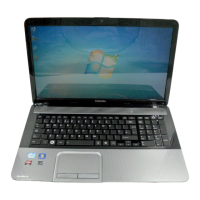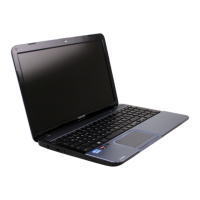
Do you have a question about the Toshiba Satellite L845 and is the answer not in the manual?
| Webcam | HD Webcam |
|---|---|
| Processor Speed | 2.4 GHz |
| RAM | 4 GB DDR3 |
| Storage | 500 GB HDD |
| Display | 14.0-inch HD TruBrite LED Backlit Display (1366 x 768) |
| Operating System | Windows 8 |
| Optical Drive | DVD SuperMulti |
| Audio | Built-in stereo speakers, headphone jack, microphone jack |
| Wireless | 802.11 b/g/n |
| LAN | 10/100 Ethernet |
| Ports | USB 2.0, USB 3.0, HDMI, VGA, RJ-45 |
| Battery | 6-cell lithium-ion |
| Bluetooth | Bluetooth 4.0 |
| Card Reader | SD card reader |
Lists essential hardware and documentation included with the computer.
Step-by-step guide on how to connect the AC adaptor for power.
Instructions on how to safely open the computer's display panel.
Procedures for turning the computer on, starting for the first time, and turning it off.
Explains how to use Sleep and Hibernation modes for power saving and quick resume.
Describes methods to restart the computer when necessary.
Identifies components on the front of the computer when the display is closed.
Details ports and slots on the left side of the computer.
Identifies ports and vents on the right side of the computer.
Shows components located on the back and underside of the computer.
Identifies components visible when the computer display is open.
Details internal hardware parts like CPU, HDD, RAM, controllers, and power saving technologies.
Guide on operating the touch pad and its control buttons for navigation.
Covers keyboard indicators, function keys, FN key combinations, and special keys.
Instructions on using optical drives, including loading, removing, and writing discs.
Details on using TOSHIBA VIDEO PLAYER and TOSHIBA Blu-ray Disc Player for media playback.
Information on Wireless LAN and Bluetooth, including settings, security, and interoperability.
Connecting peripherals like monitors, HDMI devices, and managing memory media.
Explains volume control, microphone levels, audio enhancements, and SmartAudio utility.
Overview of pre-installed utilities like PC Diagnostic Tool, Password Utility, and ConfigFree.
Describes special features like Hot keys, auto power off, Sleep/Hibernation, and passwords.
Covers Sleep Utility, Face Recognition, HW Setup, PC Health Monitor, and System Recovery procedures.
Explains battery status and power indicator lights for AC adaptor and battery.
Details battery types, care, charging, monitoring, extending life, and replacement.
Describes Shut Down, Hibernation, and Sleep modes for managing computer power states.
Guidelines for identifying and resolving computer issues effectively.
Basic checks for common problems like peripherals, connections, and device recognition.
Steps to troubleshoot program freezes, startup failures, and common hardware problems.
Addresses issues related to Power, Battery, Keyboard, Display, HDD, Optical Drive, Memory, Touch Pad, USB, Sound, and LAN.
Guidance on contacting TOSHIBA support and utilizing available resources for assistance.
Details physical dimensions, operating temperature, humidity, and altitude requirements.
Specifies power requirements and external monitor port pin assignments.
Lists certification agencies for power cords and standards for plug configurations.
Discusses CPU performance, 64-bit computing, memory usage, and battery life factors.
Covers HDD capacity, LCD characteristics, GPU performance, and wireless LAN speed.
Explains how copy protection standards may affect media recording or viewing.
Details Wireless LAN and Bluetooth interoperability, and health considerations for wireless devices.
Outlines frequency usage restrictions and regulations for wireless devices in different regions.
Lists approved countries/regions for specific wireless LAN and Bluetooth modules.











